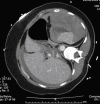Splenic rupture following thrombolysis treatment for acute myocardial infarction
- PMID: 24960736
- PMCID: PMC3649557
- DOI: 10.1093/jscr/2012.7.11
Splenic rupture following thrombolysis treatment for acute myocardial infarction
Abstract
Thrombolysis is the gold standard of treatment for acute myocardial infarction (MI), however can be associated with haemorrhagic complications. To date, splenic rupture following thrombolysis has only been reported in those with an associated history of major trauma or splenomegaly. We report a case of a 47-year old female who developed splenic rupture following thrombolysis treatment with no history of trauma or splenomegaly. She received Tenecteplase therapy for an inferior MI, and six hours later she developed upper abdominal pain and hypotension. CT showed large haemoperitoneum with a large peri-splenic haematoma. She subsequently underwent a laparotomy and splenectomy. Patient remained well and was discharged home eight days postoperatively.
© JSCR.
Figures
References
-
- National Institute of Clinical Excellence. Guidance on the use of drugs for early thrombolysis in the treatment of acute myocardial infarction (2002) www.nice.org.uk/nicemedia/live/11480/32504/32504.pdf
-
- The GUSTO Investigators An international randomised trial comparing four thrombolytic strategies for acute myocardial infarction and venous thromboembolism. N Engl J Med 1993; 329: 673–82 - PubMed
-
- Lauer J, Heger J, Mirr M. Haemorrhagic complications of thrombolytic therapy. Chest 1995; 108: 1520–3 - PubMed
-
- Berkowitz SD, Granger CB, Pieper KS, Lee KL, Gore JM, Simmoons M, Armstrong PW, Topol EJ, Califf RM. Incidence and predictors of bleeding after contemporary thrombolytic therapy for myocardial infarction. The Global Utilization of Streptokinase and Tissue Plasminogen activator for Occluded coronary arteries (GUSTO) I Investigators. Circulation 1997; 95: 2508–16 - PubMed
LinkOut - more resources
Full Text Sources


